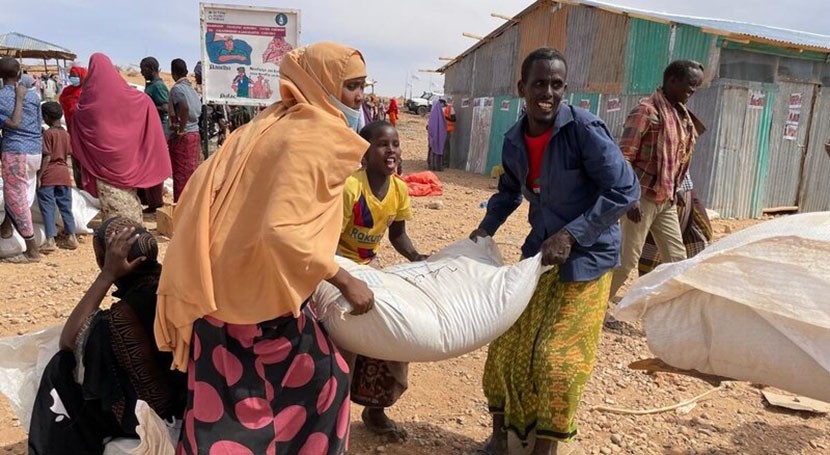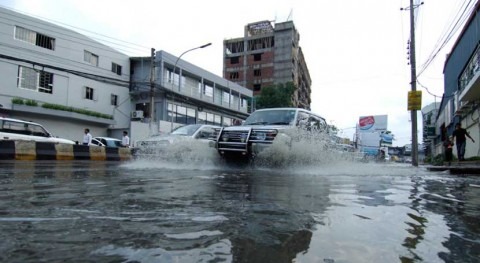More than 13 million people across Ethiopia, Kenya, and Somalia face severe hunger as the driest conditions in decades cause severe drought across the Horn of Africa, the World Food Programme (WFP) is warning.
Crop failures and an abnormally high rate of livestock deaths are dealing a crushing blow to whole communities’ ability to grow, sell and consume nutritious foods, after three consecutive failed rainy seasons.
“Harvests are ruined, livestock are dying and families are bearing the consequences of increasingly frequent climate extremes,” says Michael Dunford, WFP's Regional Director for Eastern Africa.
“Droughts in the Horn of Africa are becoming more frequent and severe and are one of the key drivers of hunger across the region, devastating livelihoods and forcing families from their homes. These impacts reinforce the need for immediate humanitarian action and the importance of building the resilience of communities for the future.”
The lack of rains is also driving displacement as families are forced to move in search of water and pasture, leading to intercommunal conflicts.
“It’s shocking when you meet people and you hear their personal stories,” says Dunford on a video call from Nairobi. “If you meet a pastoralist who’s lost all their animals, it’s devastating.”

A family feed their cows straw plucked from the roof of their home in Adadle in the Somali region of Ethiopia. Photo: WFP/Michael Tewelde
“Certainly, because of the climate changing, the situation is becoming worse,” he adds. “We really need to be investing at scale using all of the techniques that the WFP and others have developed.
“We also need to continue to build on the anticipatory actions – early warning systems, access to financing when triggers are heard, access to different types of crop or livestock insurance… there’s so much that we are doing that is cushioning the blow but [there have been] three years of insufficient rains.”
The drought has hit pastoral and farmer populations across southern Ethiopia, northern Kenya and south-central Somalia. Impacts are compounded by increases in staple food prices, inflation and low demand for agricultural labour, further challenging families’ ability to buy food. Malnutrition rates also remain high across the region and could worsen if no immediate action is taken.
“The statistics that I am seeing suggest that this is the driest this region has been in 40 years,” says Dunford. Does it translate to the worst drought in 40 years? “Well, it depends how you want to measure. In 2011 there was a drought that killed 250,000 people in Somalia. We’re not there yet.”

Michael Dunford, WFP's regional director for East Africa, inspects drought damage in Adadle, in Ethiopia's Somali region. Photo: WFP/Claire Nevill
He adds: “But don't get me wrong, the situation is dire. I met climate evacuees living in camps for internally displaced people for over a year now because they lost all their animals. They have nothing left. And the only way they can meet the basic needs of their families is by coming into the villages where they are now receiving WFP support.”
So what of the investments that WFP and others have made in the region over the course of the last 10 years? “By improving the ability of the populations to manage such climactic shocks, the needs are reduced and the impact has been lessened or delayed,” says Dunford.
Chief among his concerns now is the threat of reduced rations. “What does it mean for WFP not to be able to provide a family with the minimum monthly entitlement?” he asks.
This week, WFP will launch its Regional Drought Response Plan for the Horn of Africa, calling for US$327 million to respond to the immediate needs of 4.5 million people and help communities become more resilient to extreme climate shocks.
“[The money is] primarily for emergency response, with a proportion to continue to build capacities of communities and individuals to meet their own needs,” says Dunford. “What we can’t have is people adopting negative coping measures, either losing all their livestock or alternatively having to sell it, because once the drought is over, once the rains ultimately break, they won't have anything and they’ll still be dependent.”
Action is required immediately and at scale. “WFP has a long history of building resilience across the region. We've transformed vast swathes of territory into land that is suitable for agricultural [activities],” says Dunford. “The key for WFP is always the scale we operate at, particularly in close partnership and collaboration with the Governments at the central and regional levels and then directly with the communities and families.”
Let's take a closer look at the affected countries:
Ethiopia

People in Adadle in Ethiopia’s Somali region receive emergency assistance as drought looks set to extend into the next rainy season. Photo: WFP/Claire Nevill
An estimated 5.7 million people affected by severe drought need food assistance in Ethiopia. WFP aims to support 2.9 million people with food relief in the Somali region, including 585,000 malnourished children and mothers with nutrition treatment, and 80,000 families with mothers or young children with preventative treatment against malnutrition. This emergency response will be complemented by expanding microinsurance support for up to 18,000 at-risk pastoralists. WFP is also seeking to add 50,000 children to its school meals programme, which currently reaches 87,000 children across 254 schools in other drought affected regions.
Kenya
In Kenya, the Government declared the drought a national emergency in September 2021 and an estimated 2.8 million people are in need of assistance. WFP aims to provide urgent food assistance to more than 890,000 people in the worst affected counties as well as scale up malnutrition treatment and prevention programmes for women and children. WFP will also extend microinsurance support for smallholder farmers.
Somalia
In Somalia, the number of acutely food insecure people is expected to increase from 3.5 million to 4.6 million by May, if humanitarian assistance is not received. WFP is aiming to scale up its food assistance to support an additional 600,000 people in the first half of this year, reaching a total of almost 2.5 million.
To help prevent and treat the implications of drought, WFP will also provide nutrition support to women and children. WFP is also continuing livelihoods, resilience and food systems programmes to protect recent development gains and strengthen vulnerable Somalis against droughts and other crises in the long term.






